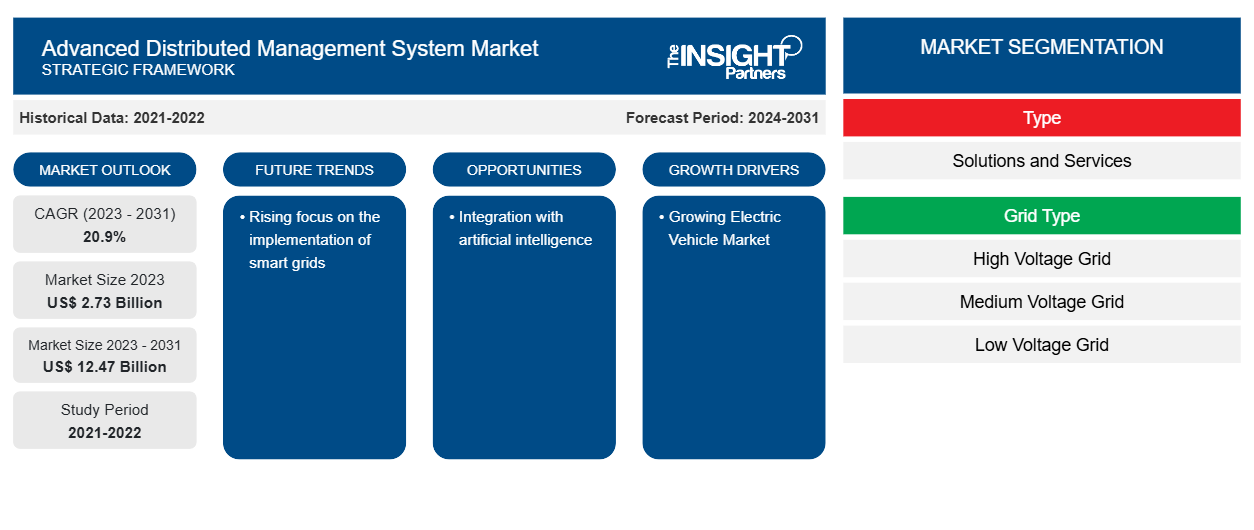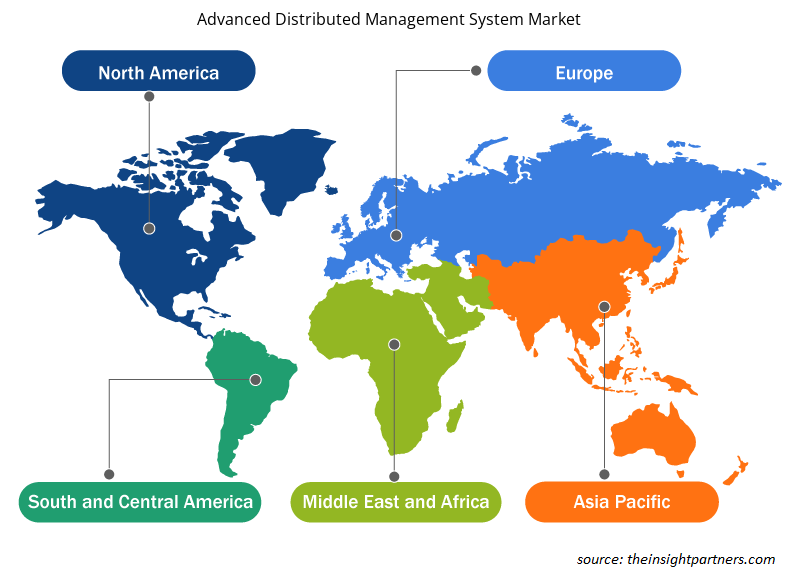高级分布式管理系统市场规模预计将从2024年的33.2亿美元增至2031年的93.5亿美元。预计2025年至2031年期间,该市场的复合年增长率将达到16.6%。高级分析、人工智能和机器学习的应用可能会在未来几年为市场带来新的趋势。
高级分布式管理系统市场分析
高级配电管理系统 (ADMS) 是一个集成软件平台,使电力公司能够实时监控、管理和优化其配电网的性能。在可再生能源、电动汽车、分布式能源 (DER) 的整合以及不断增长的消费者需求的推动下,电网基础设施日益复杂,ADMS 已成为现代电网运营的关键工具。ADMS 为电力公司提供了一个集中式平台来监督配电网的运行,并提供停电管理、故障定位和隔离、电压优化、负荷预测和实时网络建模等关键功能。与传统的孤立运行系统不同,ADMS 将监控和数据采集系统 (SCADA)、配电管理系统 (DMS) 和停电管理系统 (OMS) 整合到一个统一的界面中,从而提供电网性能的整体视图。
先进分布式管理系统市场概况
极端天气事件的发生频率和严重程度不断飙升,加上网络攻击威胁不断升级,给公用事业公司带来了前所未有的压力,迫使它们加强电网的可靠性和弹性。在这种不断变化的风险形势下,确保不间断供电和快速恢复供电已成为能源供应商、监管机构和利益相关者的战略重点。先进的配电管理系统 (ADMS) 在应对这些挑战中发挥着关键作用。这些平台提供了增强的态势感知能力,使运营商能够实时监控电网状况、识别异常情况并主动应对潜在的中断。集成的故障定位、隔离和服务恢复 (FLISR) 功能可以自动检测停电情况,在可能的情况下重新路由电力,并更高效地恢复服务,从而使公用事业公司能够最大限度地减少客户停机时间并减轻经济损失。
您可以免费定制任何报告,包括本报告的部分内容、国家级分析、Excel 数据包,以及为初创企业和大学提供优惠和折扣
先进分布式管理系统市场:战略洞察

- 获取此报告的顶级关键市场趋势。此免费样品将包括数据分析,从市场趋势到估计和预测。
先进分布式管理系统市场驱动力和机遇
对电网可靠性和弹性的需求日益增加
根据《可靠的电网,迎接电力未来》研究报告,受能源消费转型的推动,美国的电力需求预计将在不久的将来大幅增长。预计到2025年3月,数据中心的能源消耗将增长300%,而与电动出行和电动汽车(EV)充电相关的需求将空前激增9000%。因此,预计电力在最终能源消费总量中的占比将从2024年的21%增长到2050年的32%。此外,极端天气事件的发生频率和严重程度日益增加,加上网络攻击威胁不断升级,给公用事业公司带来了前所未有的压力,迫使其加强电网的可靠性和弹性。因此,确保不间断供电和快速恢复供电已成为能源供应商、监管机构和利益相关者的战略重点。ADMS解决方案提供先进的分析、系统智能和自动化控制,以确保电网在各种压力下(无论是自然灾害还是网络事件)保持稳定。通过提供增强的态势感知能力,ADMS 平台使运营商能够实时监控电网状况,识别异常情况,并主动应对潜在的中断。集成的故障定位、隔离和服务恢复 (FLISR) 功能使公用事业公司能够自动检测停电情况,在可能的情况下重新规划电力线路,并更高效地恢复服务,从而最大限度地减少客户停机时间并降低经济损失。
此外,随着电网日益数字化和分散化,快速响应中断的能力决定了电网的运营效率,并有助于电网运营商确保合规性和客户满意度。因此,对电网可靠性和弹性日益增长的需求推动了先进配电管理系统 (ADMS) 市场的发展。因此,对于那些寻求面向未来基础设施、降低风险敞口并在日益动荡的环境中确保业务连续性的公用事业公司而言,投资 ADMS 具有战略意义。
可再生能源的采用日益增多
可再生能源正日益超越传统能源,其发展潜力巨大,这得益于零碳排放、减少空气和水污染以及经济高效的电力生产等因素。随着化石燃料、煤炭和天然气燃烧产生的碳污染日益加剧,全球变暖加剧,对可再生能源的需求也日益增长。此外,全球许多政府都为可再生能源项目提供财政激励。未来几年,可再生能源发电项目数量的激增将为先进配电管理系统 (ADMS) 市场带来机遇。ADMS 是衡量配电站电力质量的必要工具。
国际能源署 (IEA) 表示,欧盟计划到 2030 年将可再生能源在其能源结构中的占比提升至 45%,正如其在《欧盟可再生能源电力计划》(REPowerEU Plan) 中所述。预计的增长可能反映了对 1,236 吉瓦可再生能源装机容量的需求,以及整个欧洲大陆清洁能源技术的加速推广,从而推动对 ADMS 解决方案的需求。许多欧洲国家加强了对可再生能源和供热系统的支持措施——这既源于长期气候目标,也源于俄罗斯入侵乌克兰后迫在眉睫的能源安全担忧——因此,日益复杂和分散的电网的稳定性和效率变得至关重要。此外,欧盟于 2023 年 2 月启动了旨在扩大清洁能源制造业的《绿色协议工业计划》,这凸显了欧盟致力于建设具有韧性的绿色能源基础设施的承诺。因此,全球能源格局的不断演变催生了 ADMS 解决方案的需求,使其能够有效应对波动、谐波和电网整合等挑战,这很可能在未来几年为高级配电管理系统 (ADMS) 市场创造巨大的增长机遇。
高级分布式管理系统市场报告细分分析
有助于得出先进分布式管理系统市场分析的关键部分是组件、网格类型和垂直。
- 高级分布式管理系统市场按组件细分为解决方案和服务。2024年,解决方案部分占据了更大的市场份额。
- 按电网类型,先进分布式管理系统市场分为中压电网、高压电网和低压电网。2024年,中压电网领域占据先进分布式管理系统市场的最大份额。
- 高级分布式管理系统市场按垂直细分为公用事业、工业和商业。公用事业领域在2024年占据了最大的市场份额。
高级分布式管理系统市场份额(按地区)分析
先进分布式管理系统市场报告的地理范围主要分为五个区域:北美、亚太、欧洲、中东和非洲以及南美和中美。2024年,亚太地区占据了相当大的市场份额。亚太地区先进配电管理系统市场正经历强劲增长,这得益于对高效、可靠和可持续能源分配解决方案日益增长的需求。快速城镇化和工业化以及可再生能源的广泛整合等关键区域趋势,正在推动公用事业公司和政府对现有电网基础设施进行现代化改造,并投资于先进的电网管理技术。作为更广泛的能源转型战略的一部分,各地区政府正在优先考虑电网升级,以增强能源安全并支持向低碳电力系统转变。智能电网技术——包括先进的计量基础设施 (AMI)、需求响应系统和自动化工具——是实现实时电网监控、运营效率和弹性的重要催化剂。
高级分布式管理系统市场区域洞察
Insight Partners 的分析师已详尽阐述了预测期内影响高级分布式管理系统市场的区域趋势和因素。本节还讨论了北美、欧洲、亚太地区、中东和非洲以及南美和中美洲的高级分布式管理系统市场细分和地域分布。

- 获取高级分布式管理系统市场的区域特定数据
高级分布式管理系统市场报告范围
| 报告属性 | 细节 |
|---|---|
| 2024年的市场规模 | 33.2亿美元 |
| 2031年的市场规模 | 93.5亿美元 |
| 全球复合年增长率(2025-2031) | 16.6% |
| 史料 | 2021-2023 |
| 预测期 | 2025-2031 |
| 涵盖的领域 | 按类型
|
| 覆盖地区和国家 | 北美
|
| 市场领导者和主要公司简介 |
|
高级分布式管理系统市场参与者密度:了解其对业务动态的影响
高级分布式管理系统 (AMS) 市场正在快速增长,这得益于终端用户需求的不断增长,而这些需求的驱动因素包括消费者偏好的不断变化、技术进步以及对产品优势的认知度不断提升。随着需求的增长,企业正在扩展其产品线,不断创新以满足消费者需求,并利用新兴趋势,从而进一步推动市场增长。
市场参与者密度是指特定市场或行业内企业或公司的分布情况。它表明特定市场空间内竞争对手(市场参与者)的数量相对于其规模或总市值而言。
在先进分布式管理系统市场运营的主要公司有:
- 西门子股份公司
- 甲骨文公司
- 施耐德电气
- 通用电气公司
- 凯捷
- 艾默生电气公司
免责声明:以上列出的公司没有按照任何特定顺序排列。

- 获取高级分布式管理系统市场顶级关键参与者概述
先进分布式管理系统市场新闻和最新发展
高级分布式管理系统市场评估是通过收集一手和二手资料后进行的定性和定量数据进行的,这些数据包括重要的企业出版物、协会数据和数据库。以下列出了市场的一些发展情况:
- 领先的 ADMS 软件提供商 Survalent 与其本地合作伙伴 Electroval(一家自动化解决方案、电气材料和设备的区域供应商)携手,成功中标,为哥斯达黎加联邦电力公司 Instituto Costarricense de Electricidad (ICE) 提供先进的 ADMS 和 DERMS 解决方案。凭借此次中标,Survalent 现已成为哥斯达黎加 75% 能源配送市场 ADMS 供应商。(来源:Survalent Technology Corporation,新闻稿,2023 年 4 月)
- Aspen Technology, Inc. 宣布扩大与奥马哈公共电力区 (OPPD) 的战略合作伙伴关系,以支持该公用事业公司到2050年实现净零碳排放的目标。AspenTech 将提供其数字电网管理 (DGM) 软件套件,用于监控、智能调度和控制 OPPD 电网中的分布式能源 (DER),同时确保内布拉斯加州 5,000 平方英里范围内 88.5 万人口的电力供应可靠。(来源:Aspen Technology, Inc,新闻稿,2024 年 8 月)
高级分布式管理系统市场报告覆盖范围和交付成果
《先进分布式管理系统市场规模和预测(2021-2031)》报告对以下领域进行了详细的市场分析:
- 先进分布式管理系统市场规模以及涵盖范围之内所有关键细分市场的全球、区域和国家层面的预测
- 先进的分布式管理系统市场趋势,以及驱动因素、限制因素和关键机遇等市场动态
- 详细的 PEST 和 SWOT 分析
- 先进的分布式管理系统市场分析涵盖关键市场趋势、全球和区域框架、主要参与者、法规和最新市场发展
- 行业格局和竞争分析,涵盖市场集中度、热图分析、知名参与者以及先进分布式管理系统市场的最新发展
- 详细的公司简介
- 历史分析(2 年)、基准年、预测(7 年)及复合年增长率
- PEST和SWOT分析
- 市场规模、价值/数量 - 全球、区域、国家
- 行业和竞争格局
- Excel 数据集
近期报告
客户评价
购买理由
- 明智的决策
- 了解市场动态
- 竞争分析
- 客户洞察
- 市场预测
- 风险规避
- 战略规划
- 投资论证
- 识别新兴市场
- 优化营销策略
- 提升运营效率
- 顺应监管趋势






















 获取免费样品 - 先进的分布式管理系统市场
获取免费样品 - 先进的分布式管理系统市场